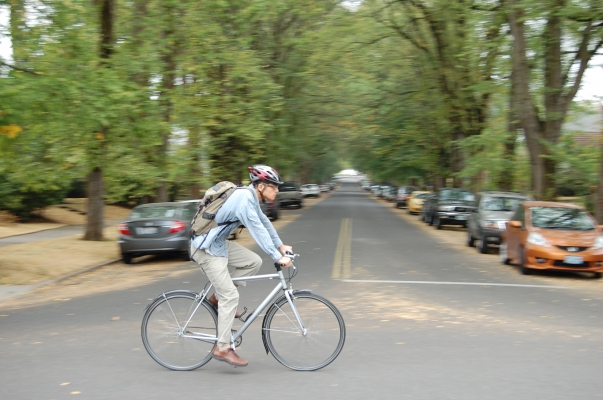Bike research leading to smarter regional investments, easier rides

When policymakers look to meet cycling goals by investing in new bicycle routes, they have little research to help them determine whether cyclists will actually use them. As a result, bicycle facilities aren’t considered equally with motor vehicle infrastructure.
That’s changing, thanks in part to OTREC research. An OTREC-funded study, the first to gather large-scale data that reveal cyclists’ actual route preference, is being published in a scientific journal (Transportation Research Part A). The findings have already been incorporated into the regional travel demand model used to make transportation investment decisions across the Portland region.
In the study, Portland State University researchers Joseph Broach, Jennifer Dill and John Gliebe (Gliebe is now with RSG Inc.) outfitted cyclists with GPS units to record which routes they chose and model the choices to reveal preferences. Previous studies have relied on stated preference surveys or less reliable methods of determining cyclists’ actual routes. The data gathering was supported by a grant from the Robert Wood Johnson Foundation through its national program Active Living Research.
The research determined not only the attractiveness of bike lanes, paths and bike boulevards, but also the effect of intersection design, turns and slope—factors that proved to be as important as the bike facility itself. While some assume that cyclists take the most direct route to any destination, the research found that cyclists take significant detours to use separated bike paths and bike boulevards. The study is the first to examine bike boulevards, the low-traffic neighborhood streets tailored for cycling.
Some findings are below:
- Separated bike paths are equivalent to reducing trip distance by 26 percent, bike boulevards by 17.9 percent.
- Cyclists are willing to detour 16.2 percent of their trip distance to avoid a left turn at a busy intersection without a traffic light.
- Each additional turn is equal to adding 7.4 percent of the trip distance.
Metro, the Portland area’s metropolitan planning organization, partnered with OTREC on the research and has incorporated the findings into its regional travel demand model. Now, when local governments want to study the impact of a bike trail along a suburban light-rail line, to use one recent example, or to compare a host of improvements to a state highway corridor, to use another, they can run the model to find the most effective way to meet their needs.
Metro has fielded calls on the bicycle modeling application from its counterpart planning organizations in Denver, Seattle, San Diego and elsewhere. The Lane Council of Governments in Eugene, Ore., has already adopted the research values for its own regional planning. In addition, the open nature of the research allows for endless new applications. Transit agency TriMet has woven the research values into its multimodal Map Trip Planner software. Users receive customized directions based on the value they place on quick, flat or bike-friendly routes. The open-source OpenTripPlanner uses these same values and has been adopted in 10 countries and five North American cities since its Portland launch.
The research draws from two OTREC projects: https://nitc.trec.pdx.edu/research/project/249 and https://nitc.trec.pdx.edu/research/project/33. The Transportation Research Part A article “Where do cyclists ride? A route choice model developed with revealed preference GPS data” is at http://bit.ly/PpsGfm (registration required).
The Oregon Transportation Research and Education Consortium is the federally funded transportation research center at Portland State University. OTREC conducts research on surface transportation, educates current and future transportation leaders and encourages the real-world use of research results.
Active Living Research, a national program of the Robert Wood Johnson Foundation, stimulates and supports research to identify environmental factors and policies that influence physical activity for children and families to inform effective childhood obesity prevention strategies, particularly in low-income and racial/ethnic communities at highest risk. Active Living Research wants solid research to be part of the public debate about active living.
